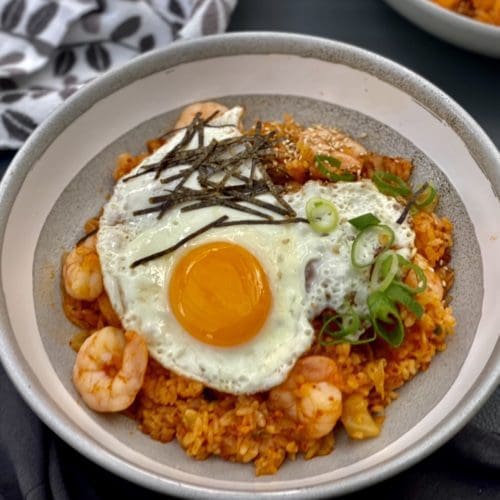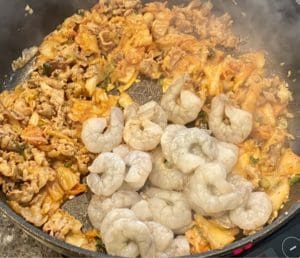
Kimchi Fried Rice with Prawn
Why not make this super tasty and popular Korean inspired Kimchi Fried Rice with Prawn and Pork for dinner tonight? You won't regret it!
Ingredients
- 1 tbsp Vegetable oil (or any neutral oil)
- 2 tbsp thinly sliced spring onions
- 2 cloves garlic (minced)
- 200 gm pork belly (sliced very thinly) (NOTE 1)
- 1 cup roughly chopped kimchi (NOTE 2)
- 200 gm raw prawns (peeled and deveined) (NOTE 3)
- 3 cups cooked rice (day old) (NOTE 4)
- 1 tbsp gochujang (NOTE 5)
- 2 tsp sesame oil
- salt to taste
Optional garnish and toppings
- sesame seeds
- spring onions (sliced thinly)
- toasted nori sheet (cut thinly)
- fried eggs
Instructions
- Heat oil in a large wok or deep frying pan heat on high heat, add in the garlic and spring onions and cook for a minute, stirring quickly so it doesn't burn. Add in the pork, cooking until it turns brown, then add in the kimchi and the prawns. Cooking and stirring until the prawns are half cooked.

- Add in rice, use a wooden spoon to stir and break any clumps of rice, add in the gochujang and sesame oil. Stir and cook until prawns are opaque and the rice has heated through, taste the fried rice and add salt if needed. Stir through and serve! Optional toppings - add spring onions, toasted nori sheets, sesame seeds and fried eggs on top of the rice before serving.

Notes
(NOTE 1) Pork belly - For convenience, I defrosted frozen sliced pork belly that was prepackaged. You can find frozen pork belly slices in Asian grocery stores, they're usually sold for Korean/Japanese BBQ or hotpot.
(NOTE 2) Kimchi has made its way around the world and is quite popular. It's Korea's famous fermented spicy and crunchy cabbage. The cabbage is usually fermented with garlic, radish, spring onions, ginger and Korean chilli powder. Kimchi is available in supermarkets, but it's cheaper to buy at an Asian grocery store. When measuring the Kimchi to cook, add in some of the liquid it came with as this will provide additional flavour to the rice.
(NOTE 3) Prawns - any size or variety of raw prawns will work. Peel and devein the prawns prior to use. For convenience, I defrosted frozen prawns that were already peeled and cleaned.
(NOTE 4) Cooked rice - I used short-grain white rice commonly used in Korean and Japanese cuisines. Jasmine rice would also work. Use cold rice that was cooked the day prior. To do this cook the rice, leave it at room temperature to cool completely, then transfer the rice to a sealed container and store it in the fridge.
(NOTE 5) Gochujang chilli paste is the heart of lots of Korean dishes, it's so popular nowadays that you should be able to pick it up from the supermarket. Gochujang is a chilli paste with sweet, savoury and spicy flavours. This chilli paste makes dishes look red and spicy, but it's actually not super spicy, the heat level (to me) is in the medium range. However, different brands of Gochujang have different levels of spiciness.
Optional Garnish and toppings - Spring onions, toasted nori sheets, sesame seeds, and fried eggs.
Leftovers - Leave the rice to cool completely at room temperature. Place the rice in a sealed container and store it in the fridge, it'll be good for up to 3 days.
A Third-Party Application calculated the calories and nutritional information, so this is an approximate guide only for one serving with no added toppings or garnish.
Cooking measurements are in Australian standard spoon and cup measurements.
Nutrition
Serving: 1ServingCalories: 365kcalCarbohydrates: 23gProtein: 12gFat: 22gSaturated Fat: 9gPolyunsaturated Fat: 3gMonounsaturated Fat: 9gCholesterol: 108mgSodium: 271mgPotassium: 135mgFiber: 1gSugar: 1gVitamin A: 29IUVitamin C: 3mgCalcium: 62mgIron: 1mg